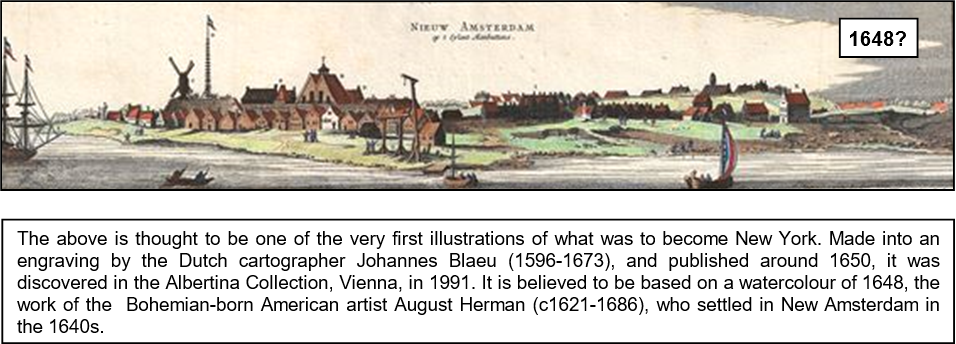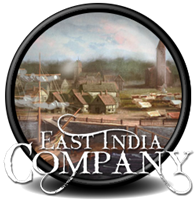


xxxxxThe English explorer Henry Hudson, working for the Dutch East India Company, reached the island of Manhattan in North America in 1609 and explored the river that now bears his name. It was not until 1626, however, that the Dutch established the settlement of New Amsterdam at the southern end of the island. It was not theirs for long. In 1664 Charles II of England sent a naval force to North America and the port was captured and renamed New York in honour of the king’s brother.
THE FOUNDING OF NEW AMSTERDAM (LATER NEW YORK) 1626 (C1)
Acknowledgement
New Amsterdam: probably by the Bohemian-born American illustrator August Herman (c1621-1686), c1648 – location unknown.
xxxxxAs we have seen, it was in 1609 that the English explorer Henry Hudson, while attempting to discover a Northwest passage to China on behalf of the Dutch East India Company, reached New York Bay in the Half Moon. He sailed some 150 miles up the river that now bears his name - reaching close to the site of present-day Albany - and, before returning home, claimed the area for the Dutch.
xxxxxFour years later the Dutch navigator Adriaen Block was obliged to winter on Manhattan island after his boat, the Tiger, was destroyed by fire, but it was not until 1624 that the Dutch West India Company established permanent settlements at Fort Orange (near Albany) and then, two years later (1626), at New Amsterdam on the southern end of Manhattan Island. In the same year, the director general of the colony, Peter Minuit, anxious to strengthen the Dutch claim to the territory, supervised the construction of Fort Amsterdam and then, so the story goes, bought the island off the local Indians for goods valued at about 60 guilders (24 dollars!) - though this amount has since been questioned! Because of its fine position, New Amsterdam soon became the administrative centre of the Dutch colony of New Netherland.
C1-1625-1649-C1-1625-1649-C1-1625-1649-C1-1652-1649-C1-1625-1649-C1-1625-1649-C1
xxxxxButxthe Dutch stay was to be short lived. In 1664 Charles II of England, having granted his brother, the Duke of York, a large area in North America (including the island of Manhattan), sent a naval force led by Richard Nicolls, a loyal cavalry commander. The town of New Amsterdam was captured in the September, and the governor of New Netherland, the able but unpopular Peter Stuyvesant, was forced to surrender the colony to the English. The settlement of New Amsterdam was renamed New York in honour of its new owner, the future King James II, and Nicolls took over the government of the colony on his behalf. In fact, the town was re-captured by the Dutch in 1673, but it was retaken in the following year, and, by the Treaty of Westminster was ceded to the English in exchange for England's holding in Suriname, a Dutch colony on the north-central coast of South America.
xxxxxIncidentally, the name Manhattan is derived from an Indian term meaning “island of hills". ……
xxxxx…… The maritime nations of Europe were making trading posts and settlements in many parts of the world during this reign. The list below refers to just a few of them:

|
1628 -
1631 -
1633 -
1635 -
1637 -
1641 -
1644 -
1646 -
|
The Dutch occupy Java and the Moluccas.
Party of English colonists settle at Salem in Massachusetts.
The Dutch West India Company establishes a settlement on
the Delaware River.
An English trading post is set up in Bengal.

The French occupy Martinique and Guadaloupe.
The Dutch settle on the island of Formosa and on
Ceylon (Sri Lanka) the following year.
English traders establish a factory at Canton.
The Portuguese surrender Malacca to the Dutch.
The Dutch make a settlement in Mauritius.
The English occupy The Bahamas.
|










